Marketing Strategies and Techniques
VerifiedAdded on 2020/07/23
|10
|2712
|35
AI Summary
The provided document is an academic report that delves into the world of marketing strategies and techniques. It discusses the importance of understanding one's target market inside out to discover efficient positioning and distribution channels. The report also explores the concept of promotion within the marketing mix, covering various elements such as sales organization, public relations, advertising, and sales promotion. It concludes by stating that every business organisation is focused on earning huge profits, with Tesco and Holiday Inn being highlighted as examples of companies prioritising customer needs and wants. The document references multiple books and journals on marketing topics, providing a comprehensive overview of the subject matter.
Contribute Materials
Your contribution can guide someone’s learning journey. Share your
documents today.
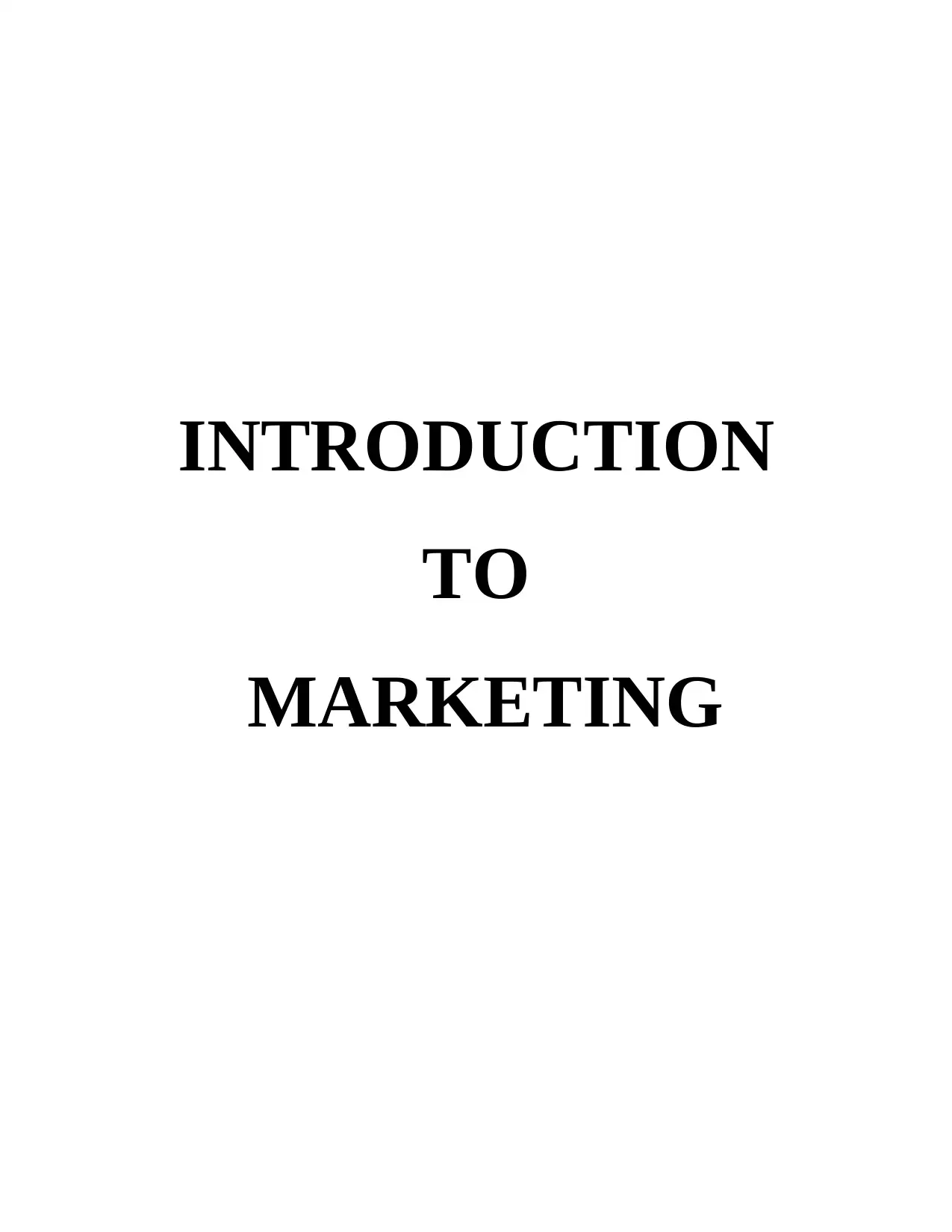
INTRODUCTION
TO
MARKETING
TO
MARKETING
Secure Best Marks with AI Grader
Need help grading? Try our AI Grader for instant feedback on your assignments.
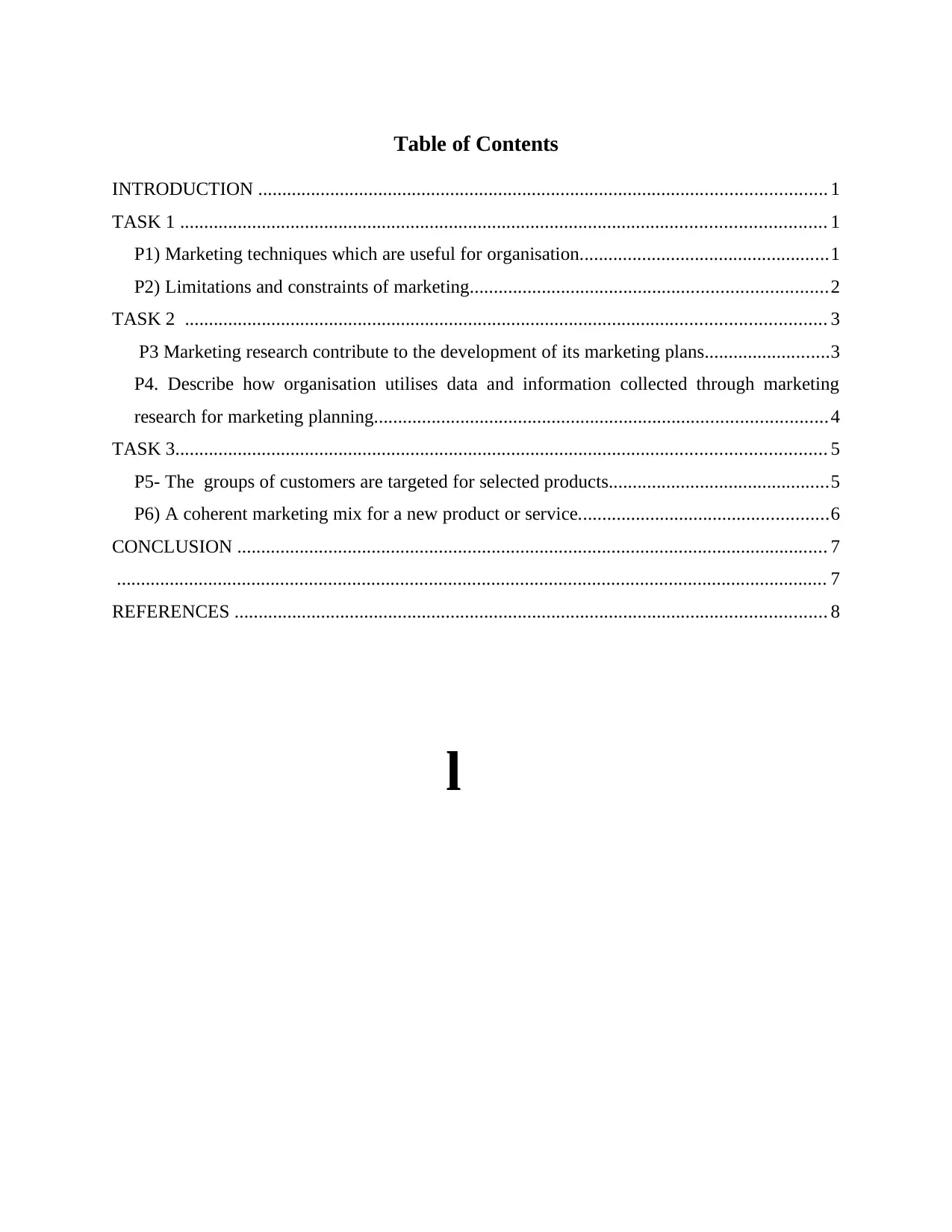
Table of Contents
INTRODUCTION ...................................................................................................................... 1
TASK 1 ...................................................................................................................................... 1
P1) Marketing techniques which are useful for organisation....................................................1
P2) Limitations and constraints of marketing..........................................................................2
TASK 2 ..................................................................................................................................... 3
P3 Marketing research contribute to the development of its marketing plans..........................3
P4. Describe how organisation utilises data and information collected through marketing
research for marketing planning.............................................................................................. 4
TASK 3....................................................................................................................................... 5
P5- The groups of customers are targeted for selected products..............................................5
P6) A coherent marketing mix for a new product or service....................................................6
CONCLUSION ........................................................................................................................... 7
.................................................................................................................................................... 7
REFERENCES ........................................................................................................................... 8
l壱
INTRODUCTION ...................................................................................................................... 1
TASK 1 ...................................................................................................................................... 1
P1) Marketing techniques which are useful for organisation....................................................1
P2) Limitations and constraints of marketing..........................................................................2
TASK 2 ..................................................................................................................................... 3
P3 Marketing research contribute to the development of its marketing plans..........................3
P4. Describe how organisation utilises data and information collected through marketing
research for marketing planning.............................................................................................. 4
TASK 3....................................................................................................................................... 5
P5- The groups of customers are targeted for selected products..............................................5
P6) A coherent marketing mix for a new product or service....................................................6
CONCLUSION ........................................................................................................................... 7
.................................................................................................................................................... 7
REFERENCES ........................................................................................................................... 8
l壱
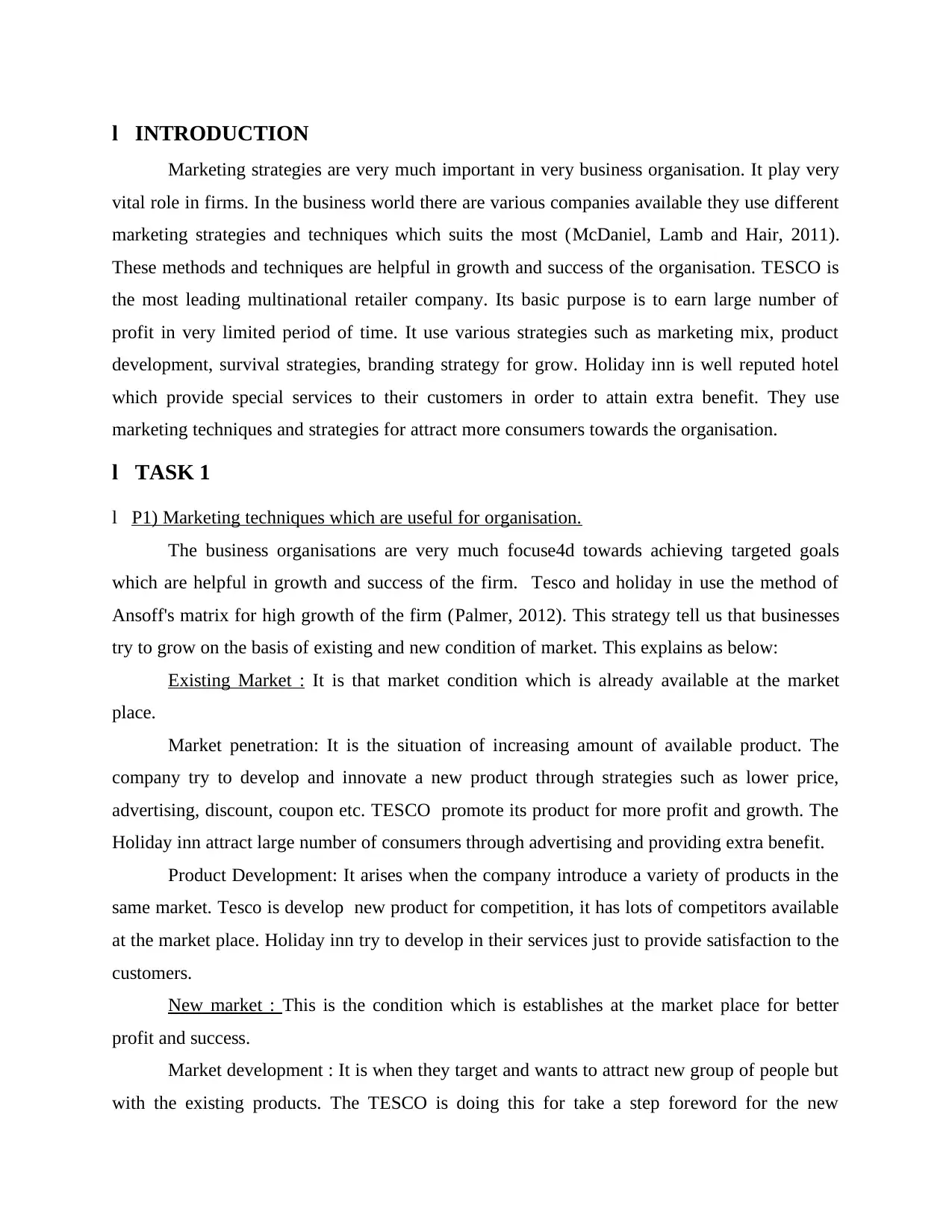
l壱INTRODUCTION
Marketing strategies are very much important in very business organisation. It play very
vital role in firms. In the business world there are various companies available they use different
marketing strategies and techniques which suits the most (McDaniel, Lamb and Hair, 2011).
These methods and techniques are helpful in growth and success of the organisation. TESCO is
the most leading multinational retailer company. Its basic purpose is to earn large number of
profit in very limited period of time. It use various strategies such as marketing mix, product
development, survival strategies, branding strategy for grow. Holiday inn is well reputed hotel
which provide special services to their customers in order to attain extra benefit. They use
marketing techniques and strategies for attract more consumers towards the organisation.
l壱TASK 1
l弐P1) Marketing techniques which are useful for organisation.
The business organisations are very much focuse4d towards achieving targeted goals
which are helpful in growth and success of the firm. Tesco and holiday in use the method of
Ansoff's matrix for high growth of the firm (Palmer, 2012). This strategy tell us that businesses
try to grow on the basis of existing and new condition of market. This explains as below:
Existing Market : It is that market condition which is already available at the market
place.
Market penetration: It is the situation of increasing amount of available product. The
company try to develop and innovate a new product through strategies such as lower price,
advertising, discount, coupon etc. TESCO promote its product for more profit and growth. The
Holiday inn attract large number of consumers through advertising and providing extra benefit.
Product Development: It arises when the company introduce a variety of products in the
same market. Tesco is develop new product for competition, it has lots of competitors available
at the market place. Holiday inn try to develop in their services just to provide satisfaction to the
customers.
New market : This is the condition which is establishes at the market place for better
profit and success.
Market development : It is when they target and wants to attract new group of people but
with the existing products. The TESCO is doing this for take a step foreword for the new
Marketing strategies are very much important in very business organisation. It play very
vital role in firms. In the business world there are various companies available they use different
marketing strategies and techniques which suits the most (McDaniel, Lamb and Hair, 2011).
These methods and techniques are helpful in growth and success of the organisation. TESCO is
the most leading multinational retailer company. Its basic purpose is to earn large number of
profit in very limited period of time. It use various strategies such as marketing mix, product
development, survival strategies, branding strategy for grow. Holiday inn is well reputed hotel
which provide special services to their customers in order to attain extra benefit. They use
marketing techniques and strategies for attract more consumers towards the organisation.
l壱TASK 1
l弐P1) Marketing techniques which are useful for organisation.
The business organisations are very much focuse4d towards achieving targeted goals
which are helpful in growth and success of the firm. Tesco and holiday in use the method of
Ansoff's matrix for high growth of the firm (Palmer, 2012). This strategy tell us that businesses
try to grow on the basis of existing and new condition of market. This explains as below:
Existing Market : It is that market condition which is already available at the market
place.
Market penetration: It is the situation of increasing amount of available product. The
company try to develop and innovate a new product through strategies such as lower price,
advertising, discount, coupon etc. TESCO promote its product for more profit and growth. The
Holiday inn attract large number of consumers through advertising and providing extra benefit.
Product Development: It arises when the company introduce a variety of products in the
same market. Tesco is develop new product for competition, it has lots of competitors available
at the market place. Holiday inn try to develop in their services just to provide satisfaction to the
customers.
New market : This is the condition which is establishes at the market place for better
profit and success.
Market development : It is when they target and wants to attract new group of people but
with the existing products. The TESCO is doing this for take a step foreword for the new
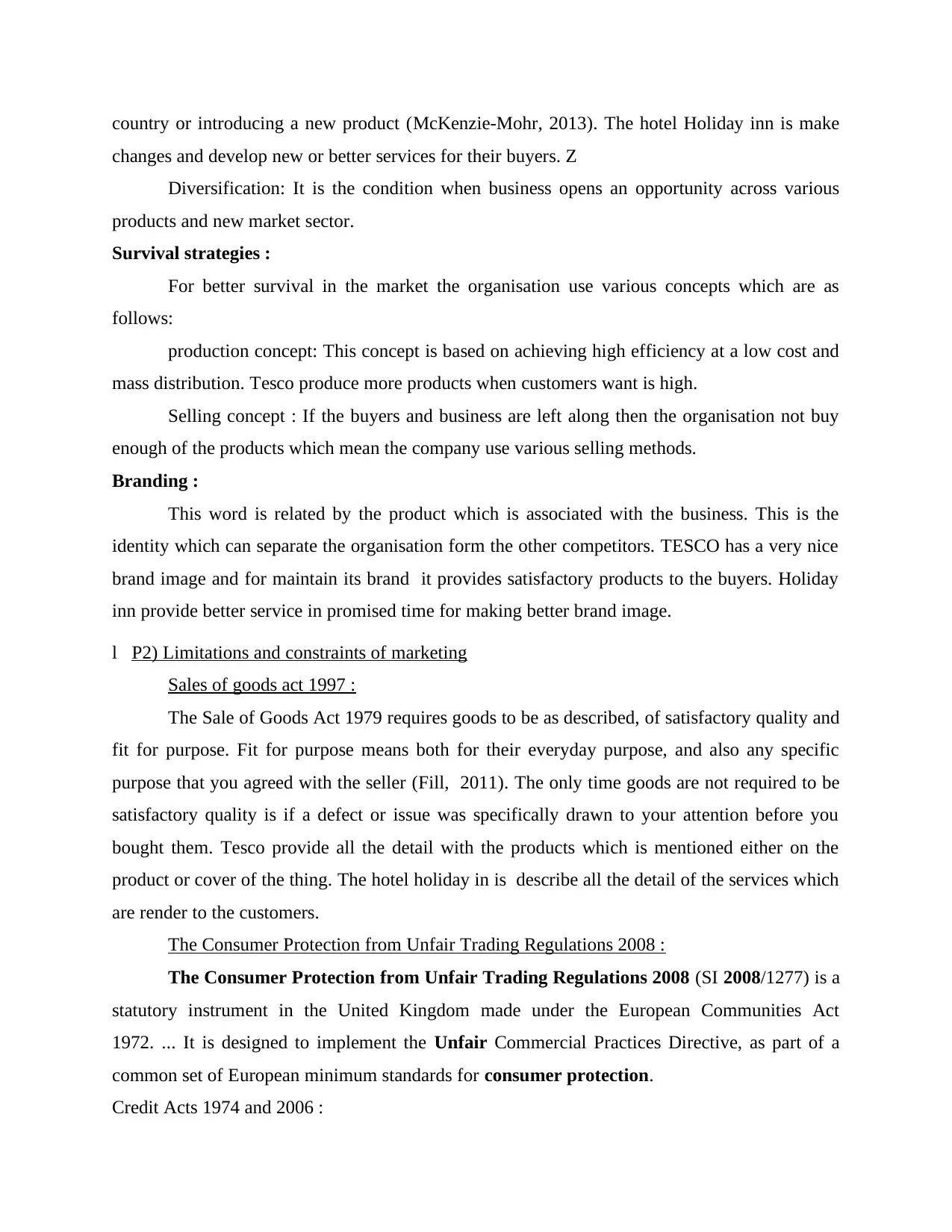
country or introducing a new product (McKenzie-Mohr, 2013). The hotel Holiday inn is make
changes and develop new or better services for their buyers. Z
Diversification: It is the condition when business opens an opportunity across various
products and new market sector.
Survival strategies :
For better survival in the market the organisation use various concepts which are as
follows:
production concept: This concept is based on achieving high efficiency at a low cost and
mass distribution. Tesco produce more products when customers want is high.
Selling concept : If the buyers and business are left along then the organisation not buy
enough of the products which mean the company use various selling methods.
Branding :
This word is related by the product which is associated with the business. This is the
identity which can separate the organisation form the other competitors. TESCO has a very nice
brand image and for maintain its brand it provides satisfactory products to the buyers. Holiday
inn provide better service in promised time for making better brand image.
l弐P2) Limitations and constraints of marketing
Sales of goods act 1997 :
The Sale of Goods Act 1979 requires goods to be as described, of satisfactory quality and
fit for purpose. Fit for purpose means both for their everyday purpose, and also any specific
purpose that you agreed with the seller (Fill, 2011). The only time goods are not required to be
satisfactory quality is if a defect or issue was specifically drawn to your attention before you
bought them. Tesco provide all the detail with the products which is mentioned either on the
product or cover of the thing. The hotel holiday in is describe all the detail of the services which
are render to the customers.
The Consumer Protection from Unfair Trading Regulations 2008 :
The Consumer Protection from Unfair Trading Regulations 2008 (SI 2008/1277) is a
statutory instrument in the United Kingdom made under the European Communities Act
1972. ... It is designed to implement the Unfair Commercial Practices Directive, as part of a
common set of European minimum standards for consumer protection.
Credit Acts 1974 and 2006 :
changes and develop new or better services for their buyers. Z
Diversification: It is the condition when business opens an opportunity across various
products and new market sector.
Survival strategies :
For better survival in the market the organisation use various concepts which are as
follows:
production concept: This concept is based on achieving high efficiency at a low cost and
mass distribution. Tesco produce more products when customers want is high.
Selling concept : If the buyers and business are left along then the organisation not buy
enough of the products which mean the company use various selling methods.
Branding :
This word is related by the product which is associated with the business. This is the
identity which can separate the organisation form the other competitors. TESCO has a very nice
brand image and for maintain its brand it provides satisfactory products to the buyers. Holiday
inn provide better service in promised time for making better brand image.
l弐P2) Limitations and constraints of marketing
Sales of goods act 1997 :
The Sale of Goods Act 1979 requires goods to be as described, of satisfactory quality and
fit for purpose. Fit for purpose means both for their everyday purpose, and also any specific
purpose that you agreed with the seller (Fill, 2011). The only time goods are not required to be
satisfactory quality is if a defect or issue was specifically drawn to your attention before you
bought them. Tesco provide all the detail with the products which is mentioned either on the
product or cover of the thing. The hotel holiday in is describe all the detail of the services which
are render to the customers.
The Consumer Protection from Unfair Trading Regulations 2008 :
The Consumer Protection from Unfair Trading Regulations 2008 (SI 2008/1277) is a
statutory instrument in the United Kingdom made under the European Communities Act
1972. ... It is designed to implement the Unfair Commercial Practices Directive, as part of a
common set of European minimum standards for consumer protection.
Credit Acts 1974 and 2006 :
Secure Best Marks with AI Grader
Need help grading? Try our AI Grader for instant feedback on your assignments.
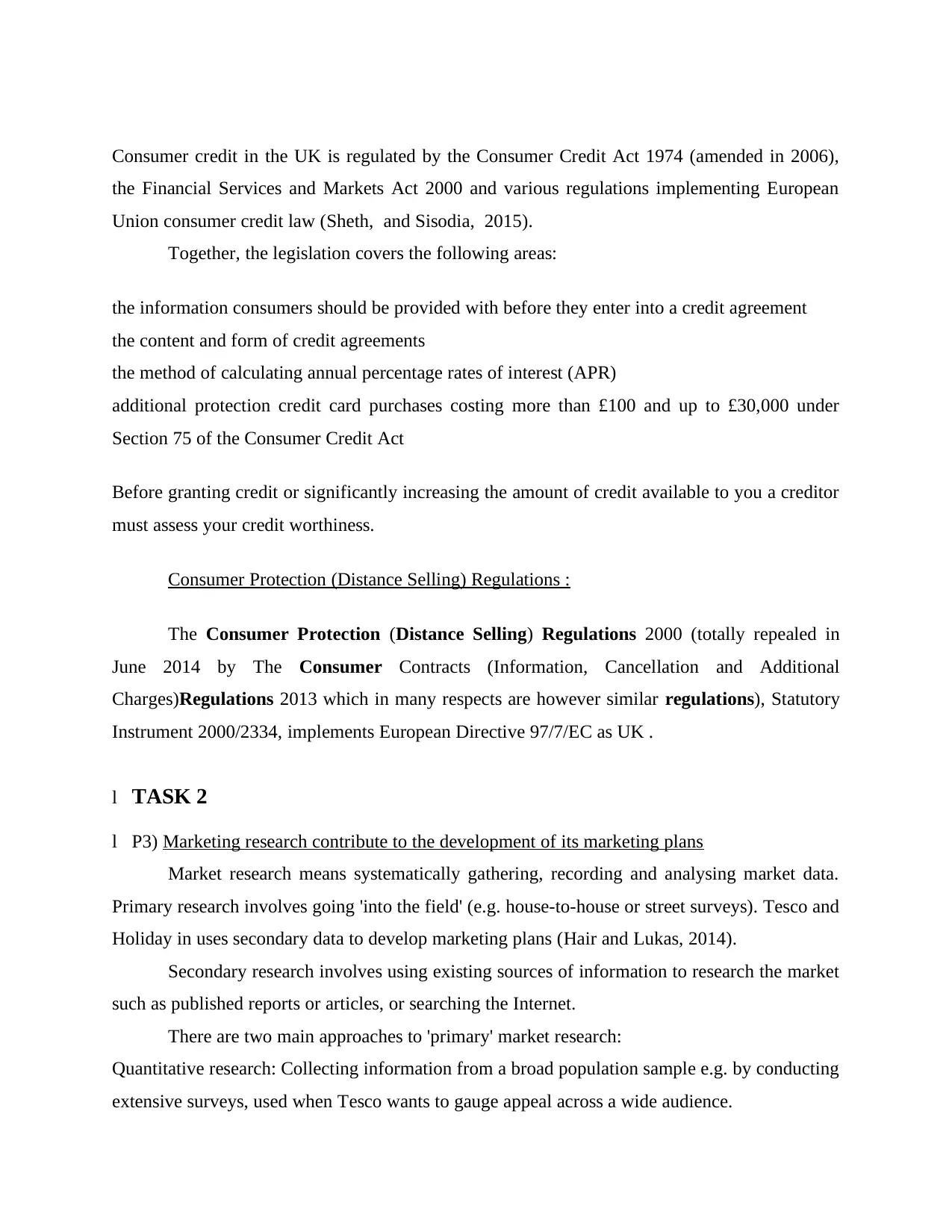
Consumer credit in the UK is regulated by the Consumer Credit Act 1974 (amended in 2006),
the Financial Services and Markets Act 2000 and various regulations implementing European
Union consumer credit law (Sheth, and Sisodia, 2015).
Together, the legislation covers the following areas:
the information consumers should be provided with before they enter into a credit agreement
the content and form of credit agreements
the method of calculating annual percentage rates of interest (APR)
additional protection credit card purchases costing more than £100 and up to £30,000 under
Section 75 of the Consumer Credit Act
Before granting credit or significantly increasing the amount of credit available to you a creditor
must assess your credit worthiness.
Consumer Protection (Distance Selling) Regulations :
The Consumer Protection (Distance Selling) Regulations 2000 (totally repealed in
June 2014 by The Consumer Contracts (Information, Cancellation and Additional
Charges)Regulations 2013 which in many respects are however similar regulations), Statutory
Instrument 2000/2334, implements European Directive 97/7/EC as UK .
l弐TASK 2
l弐P3) Marketing research contribute to the development of its marketing plans
Market research means systematically gathering, recording and analysing market data.
Primary research involves going 'into the field' (e.g. house-to-house or street surveys). Tesco and
Holiday in uses secondary data to develop marketing plans (Hair and Lukas, 2014).
Secondary research involves using existing sources of information to research the market
such as published reports or articles, or searching the Internet.
There are two main approaches to 'primary' market research:
Quantitative research: Collecting information from a broad population sample e.g. by conducting
extensive surveys, used when Tesco wants to gauge appeal across a wide audience.
the Financial Services and Markets Act 2000 and various regulations implementing European
Union consumer credit law (Sheth, and Sisodia, 2015).
Together, the legislation covers the following areas:
the information consumers should be provided with before they enter into a credit agreement
the content and form of credit agreements
the method of calculating annual percentage rates of interest (APR)
additional protection credit card purchases costing more than £100 and up to £30,000 under
Section 75 of the Consumer Credit Act
Before granting credit or significantly increasing the amount of credit available to you a creditor
must assess your credit worthiness.
Consumer Protection (Distance Selling) Regulations :
The Consumer Protection (Distance Selling) Regulations 2000 (totally repealed in
June 2014 by The Consumer Contracts (Information, Cancellation and Additional
Charges)Regulations 2013 which in many respects are however similar regulations), Statutory
Instrument 2000/2334, implements European Directive 97/7/EC as UK .
l弐TASK 2
l弐P3) Marketing research contribute to the development of its marketing plans
Market research means systematically gathering, recording and analysing market data.
Primary research involves going 'into the field' (e.g. house-to-house or street surveys). Tesco and
Holiday in uses secondary data to develop marketing plans (Hair and Lukas, 2014).
Secondary research involves using existing sources of information to research the market
such as published reports or articles, or searching the Internet.
There are two main approaches to 'primary' market research:
Quantitative research: Collecting information from a broad population sample e.g. by conducting
extensive surveys, used when Tesco wants to gauge appeal across a wide audience.
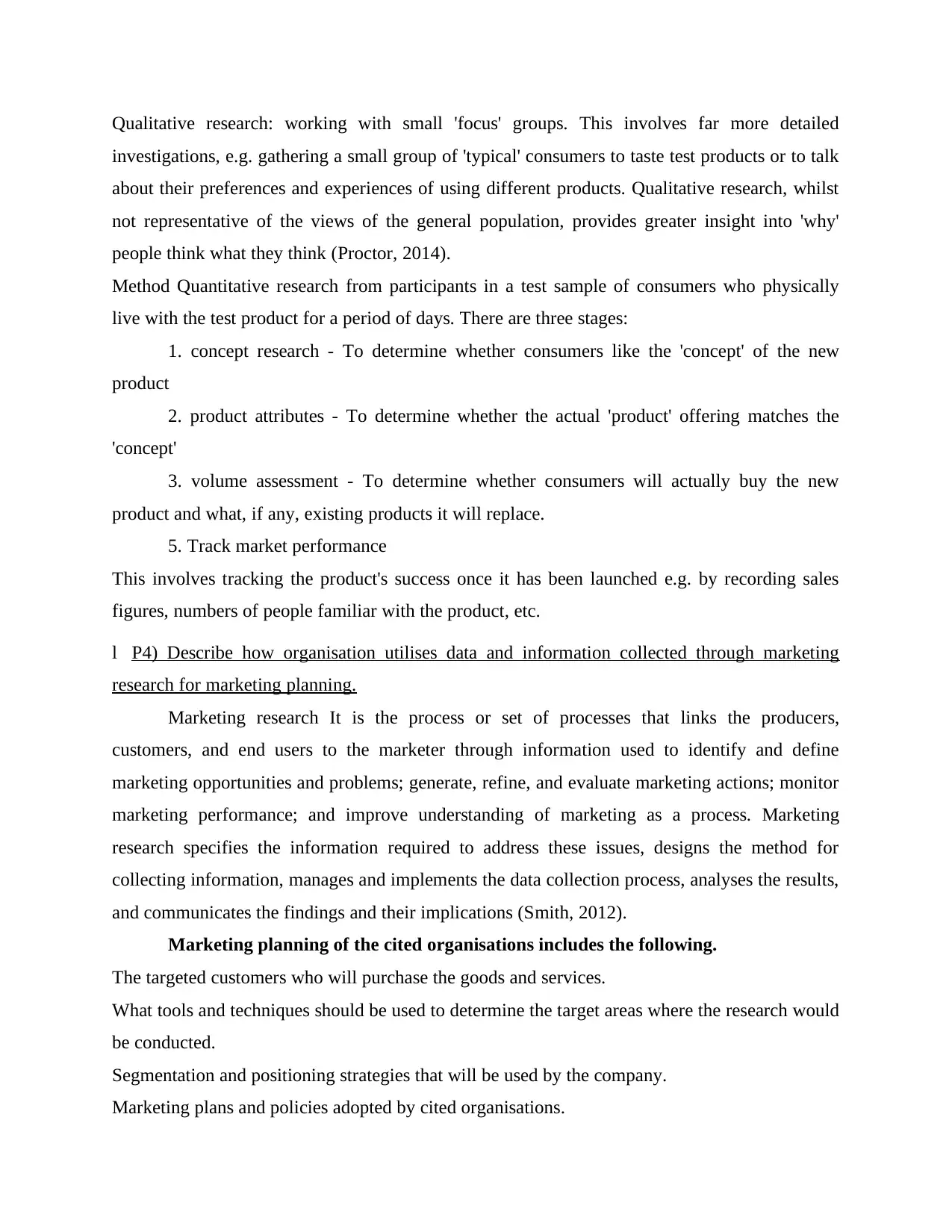
Qualitative research: working with small 'focus' groups. This involves far more detailed
investigations, e.g. gathering a small group of 'typical' consumers to taste test products or to talk
about their preferences and experiences of using different products. Qualitative research, whilst
not representative of the views of the general population, provides greater insight into 'why'
people think what they think (Proctor, 2014).
Method Quantitative research from participants in a test sample of consumers who physically
live with the test product for a period of days. There are three stages:
1. concept research - To determine whether consumers like the 'concept' of the new
product
2. product attributes - To determine whether the actual 'product' offering matches the
'concept'
3. volume assessment - To determine whether consumers will actually buy the new
product and what, if any, existing products it will replace.
5. Track market performance
This involves tracking the product's success once it has been launched e.g. by recording sales
figures, numbers of people familiar with the product, etc.
l弐P4) Describe how organisation utilises data and information collected through marketing
research for marketing planning.
Marketing research It is the process or set of processes that links the producers,
customers, and end users to the marketer through information used to identify and define
marketing opportunities and problems; generate, refine, and evaluate marketing actions; monitor
marketing performance; and improve understanding of marketing as a process. Marketing
research specifies the information required to address these issues, designs the method for
collecting information, manages and implements the data collection process, analyses the results,
and communicates the findings and their implications (Smith, 2012).
Marketing planning of the cited organisations includes the following.
The targeted customers who will purchase the goods and services.
What tools and techniques should be used to determine the target areas where the research would
be conducted.
Segmentation and positioning strategies that will be used by the company.
Marketing plans and policies adopted by cited organisations.
investigations, e.g. gathering a small group of 'typical' consumers to taste test products or to talk
about their preferences and experiences of using different products. Qualitative research, whilst
not representative of the views of the general population, provides greater insight into 'why'
people think what they think (Proctor, 2014).
Method Quantitative research from participants in a test sample of consumers who physically
live with the test product for a period of days. There are three stages:
1. concept research - To determine whether consumers like the 'concept' of the new
product
2. product attributes - To determine whether the actual 'product' offering matches the
'concept'
3. volume assessment - To determine whether consumers will actually buy the new
product and what, if any, existing products it will replace.
5. Track market performance
This involves tracking the product's success once it has been launched e.g. by recording sales
figures, numbers of people familiar with the product, etc.
l弐P4) Describe how organisation utilises data and information collected through marketing
research for marketing planning.
Marketing research It is the process or set of processes that links the producers,
customers, and end users to the marketer through information used to identify and define
marketing opportunities and problems; generate, refine, and evaluate marketing actions; monitor
marketing performance; and improve understanding of marketing as a process. Marketing
research specifies the information required to address these issues, designs the method for
collecting information, manages and implements the data collection process, analyses the results,
and communicates the findings and their implications (Smith, 2012).
Marketing planning of the cited organisations includes the following.
The targeted customers who will purchase the goods and services.
What tools and techniques should be used to determine the target areas where the research would
be conducted.
Segmentation and positioning strategies that will be used by the company.
Marketing plans and policies adopted by cited organisations.
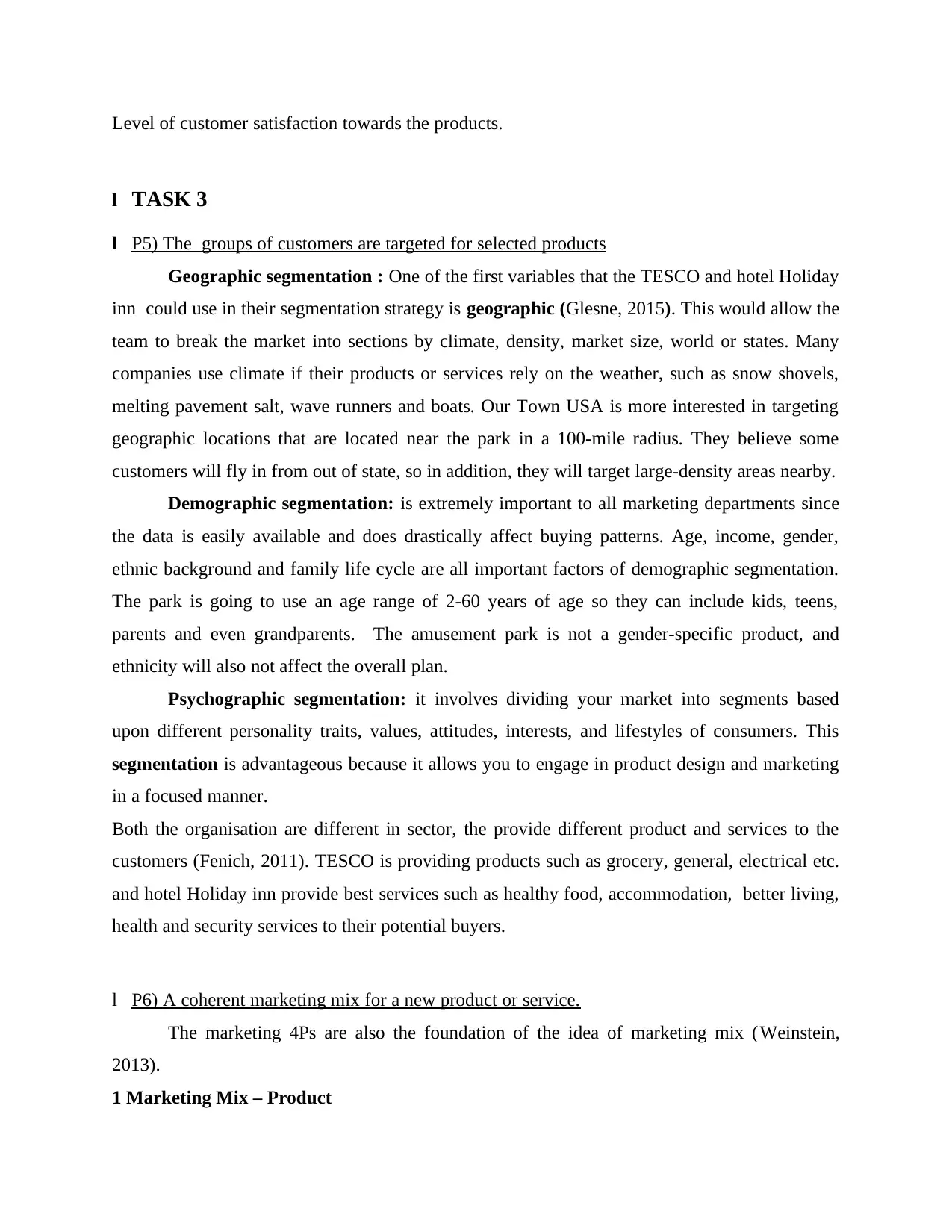
Level of customer satisfaction towards the products.
l壱TASK 3
l壱P5) The groups of customers are targeted for selected products
Geographic segmentation : One of the first variables that the TESCO and hotel Holiday
inn could use in their segmentation strategy is geographic (Glesne, 2015). This would allow the
team to break the market into sections by climate, density, market size, world or states. Many
companies use climate if their products or services rely on the weather, such as snow shovels,
melting pavement salt, wave runners and boats. Our Town USA is more interested in targeting
geographic locations that are located near the park in a 100-mile radius. They believe some
customers will fly in from out of state, so in addition, they will target large-density areas nearby.
Demographic segmentation: is extremely important to all marketing departments since
the data is easily available and does drastically affect buying patterns. Age, income, gender,
ethnic background and family life cycle are all important factors of demographic segmentation.
The park is going to use an age range of 2-60 years of age so they can include kids, teens,
parents and even grandparents. The amusement park is not a gender-specific product, and
ethnicity will also not affect the overall plan.
Psychographic segmentation: it involves dividing your market into segments based
upon different personality traits, values, attitudes, interests, and lifestyles of consumers. This
segmentation is advantageous because it allows you to engage in product design and marketing
in a focused manner.
Both the organisation are different in sector, the provide different product and services to the
customers (Fenich, 2011). TESCO is providing products such as grocery, general, electrical etc.
and hotel Holiday inn provide best services such as healthy food, accommodation, better living,
health and security services to their potential buyers.
l弐P6) A coherent marketing mix for a new product or service.
The marketing 4Ps are also the foundation of the idea of marketing mix (Weinstein,
2013).
1 Marketing Mix – Product
l壱TASK 3
l壱P5) The groups of customers are targeted for selected products
Geographic segmentation : One of the first variables that the TESCO and hotel Holiday
inn could use in their segmentation strategy is geographic (Glesne, 2015). This would allow the
team to break the market into sections by climate, density, market size, world or states. Many
companies use climate if their products or services rely on the weather, such as snow shovels,
melting pavement salt, wave runners and boats. Our Town USA is more interested in targeting
geographic locations that are located near the park in a 100-mile radius. They believe some
customers will fly in from out of state, so in addition, they will target large-density areas nearby.
Demographic segmentation: is extremely important to all marketing departments since
the data is easily available and does drastically affect buying patterns. Age, income, gender,
ethnic background and family life cycle are all important factors of demographic segmentation.
The park is going to use an age range of 2-60 years of age so they can include kids, teens,
parents and even grandparents. The amusement park is not a gender-specific product, and
ethnicity will also not affect the overall plan.
Psychographic segmentation: it involves dividing your market into segments based
upon different personality traits, values, attitudes, interests, and lifestyles of consumers. This
segmentation is advantageous because it allows you to engage in product design and marketing
in a focused manner.
Both the organisation are different in sector, the provide different product and services to the
customers (Fenich, 2011). TESCO is providing products such as grocery, general, electrical etc.
and hotel Holiday inn provide best services such as healthy food, accommodation, better living,
health and security services to their potential buyers.
l弐P6) A coherent marketing mix for a new product or service.
The marketing 4Ps are also the foundation of the idea of marketing mix (Weinstein,
2013).
1 Marketing Mix – Product
Paraphrase This Document
Need a fresh take? Get an instant paraphrase of this document with our AI Paraphraser
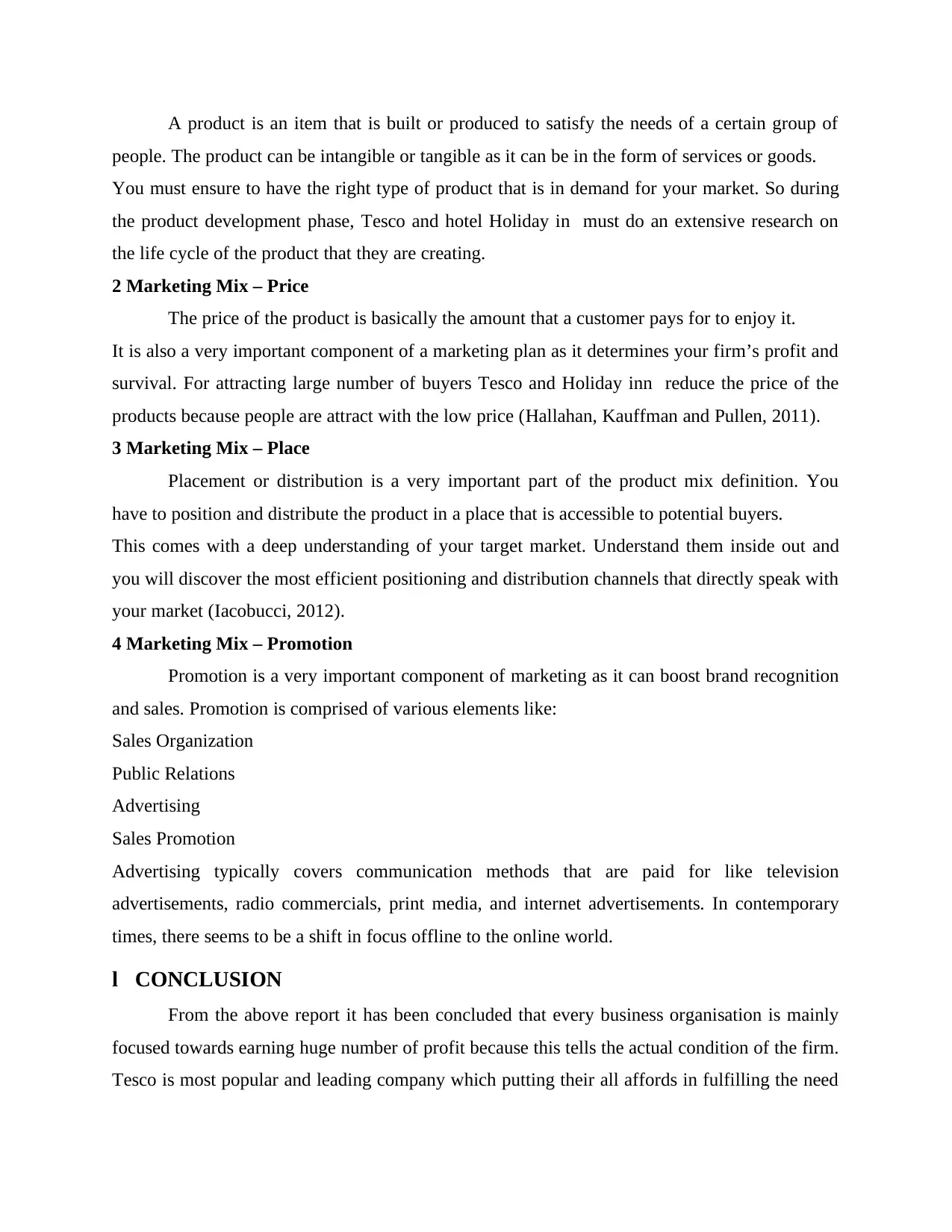
A product is an item that is built or produced to satisfy the needs of a certain group of
people. The product can be intangible or tangible as it can be in the form of services or goods.
You must ensure to have the right type of product that is in demand for your market. So during
the product development phase, Tesco and hotel Holiday in must do an extensive research on
the life cycle of the product that they are creating.
2 Marketing Mix – Price
The price of the product is basically the amount that a customer pays for to enjoy it.
It is also a very important component of a marketing plan as it determines your firm’s profit and
survival. For attracting large number of buyers Tesco and Holiday inn reduce the price of the
products because people are attract with the low price (Hallahan, Kauffman and Pullen, 2011).
3 Marketing Mix – Place
Placement or distribution is a very important part of the product mix definition. You
have to position and distribute the product in a place that is accessible to potential buyers.
This comes with a deep understanding of your target market. Understand them inside out and
you will discover the most efficient positioning and distribution channels that directly speak with
your market (Iacobucci, 2012).
4 Marketing Mix – Promotion
Promotion is a very important component of marketing as it can boost brand recognition
and sales. Promotion is comprised of various elements like:
Sales Organization
Public Relations
Advertising
Sales Promotion
Advertising typically covers communication methods that are paid for like television
advertisements, radio commercials, print media, and internet advertisements. In contemporary
times, there seems to be a shift in focus offline to the online world.
l壱CONCLUSION
From the above report it has been concluded that every business organisation is mainly
focused towards earning huge number of profit because this tells the actual condition of the firm.
Tesco is most popular and leading company which putting their all affords in fulfilling the need
people. The product can be intangible or tangible as it can be in the form of services or goods.
You must ensure to have the right type of product that is in demand for your market. So during
the product development phase, Tesco and hotel Holiday in must do an extensive research on
the life cycle of the product that they are creating.
2 Marketing Mix – Price
The price of the product is basically the amount that a customer pays for to enjoy it.
It is also a very important component of a marketing plan as it determines your firm’s profit and
survival. For attracting large number of buyers Tesco and Holiday inn reduce the price of the
products because people are attract with the low price (Hallahan, Kauffman and Pullen, 2011).
3 Marketing Mix – Place
Placement or distribution is a very important part of the product mix definition. You
have to position and distribute the product in a place that is accessible to potential buyers.
This comes with a deep understanding of your target market. Understand them inside out and
you will discover the most efficient positioning and distribution channels that directly speak with
your market (Iacobucci, 2012).
4 Marketing Mix – Promotion
Promotion is a very important component of marketing as it can boost brand recognition
and sales. Promotion is comprised of various elements like:
Sales Organization
Public Relations
Advertising
Sales Promotion
Advertising typically covers communication methods that are paid for like television
advertisements, radio commercials, print media, and internet advertisements. In contemporary
times, there seems to be a shift in focus offline to the online world.
l壱CONCLUSION
From the above report it has been concluded that every business organisation is mainly
focused towards earning huge number of profit because this tells the actual condition of the firm.
Tesco is most popular and leading company which putting their all affords in fulfilling the need

and want of the customers. Hotel Holiday inn is famous for its quality service. They provide best
to best services to their potential customers. Marketing strategies and techniques are used by the
every organisation, and it is helpful in developing new products at the market place.
to best services to their potential customers. Marketing strategies and techniques are used by the
every organisation, and it is helpful in developing new products at the market place.
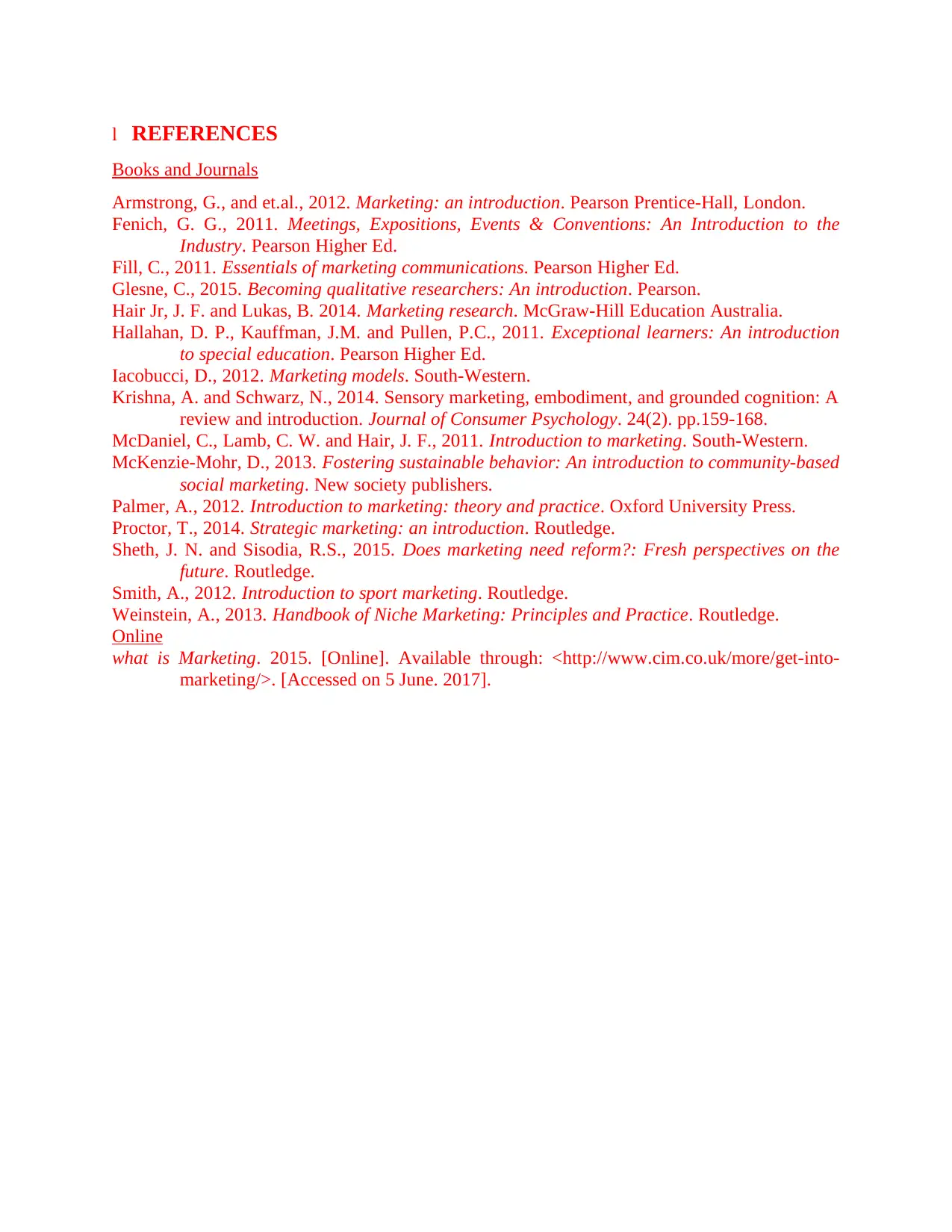
l弐REFERENCES
Books and Journals
Armstrong, G., and et.al., 2012. Marketing: an introduction. Pearson Prentice-Hall, London.
Fenich, G. G., 2011. Meetings, Expositions, Events & Conventions: An Introduction to the
Industry. Pearson Higher Ed.
Fill, C., 2011. Essentials of marketing communications. Pearson Higher Ed.
Glesne, C., 2015. Becoming qualitative researchers: An introduction. Pearson.
Hair Jr, J. F. and Lukas, B. 2014. Marketing research. McGraw-Hill Education Australia.
Hallahan, D. P., Kauffman, J.M. and Pullen, P.C., 2011. Exceptional learners: An introduction
to special education. Pearson Higher Ed.
Iacobucci, D., 2012. Marketing models. South-Western.
Krishna, A. and Schwarz, N., 2014. Sensory marketing, embodiment, and grounded cognition: A
review and introduction. Journal of Consumer Psychology. 24(2). pp.159-168.
McDaniel, C., Lamb, C. W. and Hair, J. F., 2011. Introduction to marketing. South-Western.
McKenzie-Mohr, D., 2013. Fostering sustainable behavior: An introduction to community-based
social marketing. New society publishers.
Palmer, A., 2012. Introduction to marketing: theory and practice. Oxford University Press.
Proctor, T., 2014. Strategic marketing: an introduction. Routledge.
Sheth, J. N. and Sisodia, R.S., 2015. Does marketing need reform?: Fresh perspectives on the
future. Routledge.
Smith, A., 2012. Introduction to sport marketing. Routledge.
Weinstein, A., 2013. Handbook of Niche Marketing: Principles and Practice. Routledge.
Online
what is Marketing. 2015. [Online]. Available through: <http://www.cim.co.uk/more/get-into-
marketing/>. [Accessed on 5 June. 2017].
Books and Journals
Armstrong, G., and et.al., 2012. Marketing: an introduction. Pearson Prentice-Hall, London.
Fenich, G. G., 2011. Meetings, Expositions, Events & Conventions: An Introduction to the
Industry. Pearson Higher Ed.
Fill, C., 2011. Essentials of marketing communications. Pearson Higher Ed.
Glesne, C., 2015. Becoming qualitative researchers: An introduction. Pearson.
Hair Jr, J. F. and Lukas, B. 2014. Marketing research. McGraw-Hill Education Australia.
Hallahan, D. P., Kauffman, J.M. and Pullen, P.C., 2011. Exceptional learners: An introduction
to special education. Pearson Higher Ed.
Iacobucci, D., 2012. Marketing models. South-Western.
Krishna, A. and Schwarz, N., 2014. Sensory marketing, embodiment, and grounded cognition: A
review and introduction. Journal of Consumer Psychology. 24(2). pp.159-168.
McDaniel, C., Lamb, C. W. and Hair, J. F., 2011. Introduction to marketing. South-Western.
McKenzie-Mohr, D., 2013. Fostering sustainable behavior: An introduction to community-based
social marketing. New society publishers.
Palmer, A., 2012. Introduction to marketing: theory and practice. Oxford University Press.
Proctor, T., 2014. Strategic marketing: an introduction. Routledge.
Sheth, J. N. and Sisodia, R.S., 2015. Does marketing need reform?: Fresh perspectives on the
future. Routledge.
Smith, A., 2012. Introduction to sport marketing. Routledge.
Weinstein, A., 2013. Handbook of Niche Marketing: Principles and Practice. Routledge.
Online
what is Marketing. 2015. [Online]. Available through: <http://www.cim.co.uk/more/get-into-
marketing/>. [Accessed on 5 June. 2017].
1 out of 10
Related Documents
Your All-in-One AI-Powered Toolkit for Academic Success.
+13062052269
info@desklib.com
Available 24*7 on WhatsApp / Email
![[object Object]](/_next/static/media/star-bottom.7253800d.svg)
Unlock your academic potential
© 2024 | Zucol Services PVT LTD | All rights reserved.





